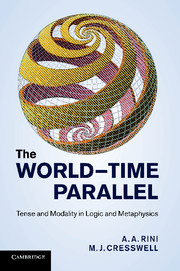Book contents
- Frontmatter
- Contents
- Preface
- Introduction
- PART I TRUTH AND INDEXICALITY
- PART II PREDICATE LOGIC: TENSE AND MODAL
- PART III TIMES AND WORLDS, OR TENSE AND MODALITY?
- 9 Primitive modality and primitive tense
- 10 ‘Modalism’ and ‘tensism’
- 11 The present and the actual
- 12 Utterances
- 13 Relativity
- PART IV DE RERUM NATURA
- Appendices
- Bibliography
- Index
11 - The present and the actual
from PART III - TIMES AND WORLDS, OR TENSE AND MODALITY?
Published online by Cambridge University Press: 05 March 2012
- Frontmatter
- Contents
- Preface
- Introduction
- PART I TRUTH AND INDEXICALITY
- PART II PREDICATE LOGIC: TENSE AND MODAL
- PART III TIMES AND WORLDS, OR TENSE AND MODALITY?
- 9 Primitive modality and primitive tense
- 10 ‘Modalism’ and ‘tensism’
- 11 The present and the actual
- 12 Utterances
- 13 Relativity
- PART IV DE RERUM NATURA
- Appendices
- Bibliography
- Index
Summary
What happens when we apply the parallel to metaphysicians' arguments about the present and the actual? In his essay ‘On what there is’ (Quine 1948) Quine is concerned to argue that no sense can be attached to the admission of ‘possibilia’ into one's ontology. On the other hand A. N. Prior is one who, we shall claim, should be understood as holding the same attitude to past or future individuals which do not currently exist. Our concern in this chapter will be to compare these attitudes. Quine introduces a philosopher he calls ‘Wyman’ – the believer in unactualised possibles. (See p. 67, above.) Quine 1948, p. 3, says that
Wyman, by the way, is one of those philosophers who have united in ruining the good old word ‘exist’.
Prior's response will be to say that Quine himself is a philosopher who has succeeded in ruining this good old word. For Prior will say that Socrates does not exist. Of course he used to but he does not now. Prior will say that he can attach no sense to the claim that there could be a sense of ‘exists’ which does not mean ‘exists now’. Much as Prior stipulates that by ‘exists’ he means ‘exists now’, Quine stipulates that by ‘exists’ he means exists somewhere in space and time. For Prior, when Quine talks of ‘what there is’, he has to mean anything that either once existed somewhere in space or presently exists somewhere in space, or will exist somewhere in space.
- Type
- Chapter
- Information
- The World-Time ParallelTense and Modality in Logic and Metaphysics, pp. 121 - 131Publisher: Cambridge University PressPrint publication year: 2012



